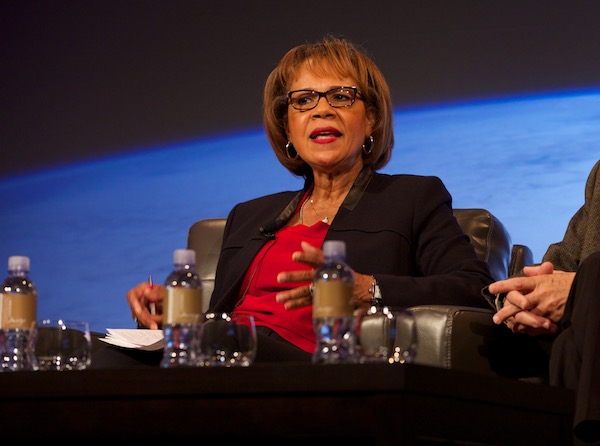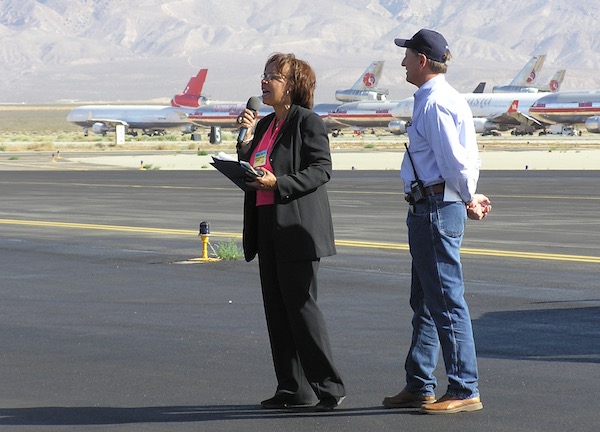Remembering Patti Grace Smith and her influence on commercial spaceflightby Jeff Foust
|
| Her work,said Muncy, “enabled the Ansari X PRIZE contest to lead to a real industry, instead of just an experimental aircraft.” |
An exception to that is the commercial space transportation industry in the US. While there may be disagreements between companies and the FAA’s Office of Commercial Space Transportation, which licenses commercial launchers, the relationship between the regulators and the regulated is far more collegial than confrontational. Part of that is due to the office’s unusual dual mandate: besides regulating launches and related activities to protect the safety of the uninvolved public, it is also charged to “encourage, facilitate, and promote” the industry, a mandate long ago removed from the rest of the FAA.
But part of that is also due to the people who led the office and implemented both the regulatory and promotional roles of the office. And that can explain the reaction from the industry to the news that the former longtime head of the office, Patti Grace Smith, unexpected passed away June 5 of cancer at the age of 68.
Smith was associate administrator for commercial space transportation at the FAA from 1997 to her retirement in 2008. Although the office had been established in the mid-1980s, she took the job just as the office transitioned from an independent entity within the Department of Transportation, the Office of Commercial Space Transportation (OCST), to a very small office—a staff of just a few dozen people—within the far larger FAA.
“Patti was the first real FAA Associate Administrator for Commercial Space Transportation,” recalled Jim Muncy, principal of space policy consultancy PoliSpace and a former House staffer. “From OCST’s arrival at FAA through her retirement in 2008, her strength of mind and character convinced multiple FAA administrators that space should be its own line of business next to the big dogs of aviation safety, air traffic, and airports.”
Smith had done little work in space prior to taking over the office. She had spent most of her career in in the communications industry, working for several companies, the Senate Commerce Committee, and the FCC. What she lacked in experience, though, she made up for with both enthusiasm for the industry and expertise in finding ways to meet the government’s mandates for public safety for an evolving industry.
When Smith became head of the office (known in the FAA’s nomenclature as AST), the buzz in the industry was about reusable launch vehicles. Several companies, like Kistler Aerospace, Pioneer Rocketplane, and Rotary Rocket Company, were working on designs of vehicles that promised to greatly reduce the cost of space access. There was just one problem: while the FAA could license the launches of those vehicles, it had no authority at the time to regulate their reentry and landing. That was not an issue for expendable vehicles, of course, but was an obstacle to companies that wanted to refly their vehicles.
Industry, with her support, pushed to give AST the authority to license reentries, which Congress granted in legislation passed in 1998. Muncy credited Smith for leading development of regulations in 1999, just after the bill’s passage, implementing that new authority for licensing reentries and reusable launch vehicles.
| “Her leadership at the FAA helped transform our industry,” said Stallmer. |
None of those vehicles planned in the 1990s would actually fly, as it turns out, but they laid the groundwork for vehicles that would follow. The ability of SpaceX today to land its Falcon 9 first stages for later reuse, and bring back its Dragon capsules from the International Space Station, has its roots in that enabling legislation and its implementation by AST.
While the reusable launch vehicle field imploded at the turn of the century, done in by the collapse of constellations of hundreds of communications satellites that were to provide much of the demand for those vehicles, a new market was emerging: commercial suborbital vehicles, designed to carry people. The Ansari X PRIZE had stimulated the development of a number of vehicles that planned to serve the space tourism market. Existing law, though, was unclear about how such vehicles would be regulated.
In the early 2000s, some people thought suborbital vehicles should be considered simply very high altitude aircraft, and treated as such, with experimental permits for test flights but full-fledged certification before they could fly commercially. Among them was Burt Rutan, the legendary aircraft designer then working on SpaceShipOne, a suborbital vehicle competing for the Ansari X PRIZE.
“It looked like an airplane, and its designer wanted to call it an airplane,” recalled Muncy during a panel session at an American Bar Association space law conference June 8, describing SpaceShipOne. AST, and others in industry, like Muncy, thought the vehicle should be regulated like a launch vehicle, which would allow commercial flights without the expense and difficulty of aircraft certification. “What was absolutely vital to us was that, after you got through the R&D phase, we not face certification.”
 Smith stayed involved with, and advocating for, the commercial spaceflight industry after retiring from the FAA, here speaking at the Future in Review Conference in 2014. (credit: Future in Review Conference) |
Smith negotiated with her counterparts within the FAA on definitions of “suborbital vehicle” and “suborbital trajectory” that allowed SpaceShipOne and similar vehicles to be treated as launch vehicles, finalizing an agreement in late 2003 (see “Easing regulatory uncertainty”, The Space Review, November 3, 2003). Those definitions were later codified into the Commercial Space Launch Amendments Act (CSLAA) of 2004, which also established an experimental permit system for tests of suborbital vehicles before seeking a launch license for commercial missions.
Muncy credited Smith for creating a regulatory framework that he argues makes any kind of suborbital industry possible. “She negotiated the all-important compromise definition of a suborbital rocket in 2003 that enabled the Ansari X PRIZE contest to lead to a real industry, instead of just an experimental aircraft,” he said.
The events of 2004, including both the flights of SpaceShipOne and the passage of the CSLAA, may have been the apex of Smith’s time at the FAA, but there was still considerable work to do. She led development of human spaceflight regulations in 2005 enabled by passage of the 2004 act, and continued to both regulate the industry but also advocate for it within and outside government. While many aspects of the commercial space transportation field have failed to grow as quickly as once envisioned, like suborbital spaceflight, those difficulties can’t be blamed on any limitations placed on it by the FAA.
Smith retired from the FAA, and government service, in 2008, but remained active in the industry up until her death. She worked as a consultant for a number of companies, including Virgin Galactic. She also served on the NASA Advisory Council and, at the time of her passing, was vice chair of the Aeronautics and Space Engineering Board of the National Academies.
Her death took most people in the spaceflight community by surprise, unaware of her cancer diagnosis. “I just saw Patti a couple of months ago and outwardly seemed her usual wonderful self,” said Courtney Stadd, who was director of OCST in the 1980s. Others noted seeing her at meetings as recently as late April, appearing to be in good health.
| “Patti integrated as a child her school in Alabama, and she was almost put in jail for it,” said Gold. “She was someone who saw the worst that this country has to offer, yet never stopped seeing the best in people.” |
Although Smith had long ago left government service, both she and her legacy at AST are fondly recalled. “Those of us that had the privilege to know and work with Patti saw so clearly how special a person she was,” said Eric Stallmer, president of the Commercial Spaceflight Federation. “Her leadership at the FAA helped transform our industry.”
Smith “made huge contributions to establishing the office’s legitimacy and fostering effective relationships with all pertinent stakeholders,” said Stadd. “She embodied her middle name and was the essence of a class lady.”
That leadership, and class, was forged at an early age. Growing up in Tuskegee, Alabama, she was among the group of students who integrated schools there during the civil rights movements of the 1960s.
“Patti integrated as a child her school in Alabama, and she was almost put in jail for it,” said Mike Gold, chairman of the FAA’s Commercial Space Transportation Advisory Committee, at the space law forum. “She was someone who saw the worst that this country has to offer, yet never stopped seeing the best in people.”
That might well explain her effectiveness at AST. For a regulator, the easiest and safest thing to do when someone proposes something outside the established bounds of law and regulations is to simply say “no.” There can be no launch accidents if there are no launches. But for an office also charged with promoting an industry, and a leader willing to see the best and not just the worst, Smith was able to stretch the bounds of what was possible, and turn a “no” into a “yes.”
Smith attended the historic first flight of SpaceShipOne—carried out under a launch license issued by her office—in June 2004, presenting commercial astronaut wings to pilot Mike Melvill after his flight. “The flight today opens a new chapter in history, making space access within the reach of ordinary citizens, like you and me,” she said in a post-flight speech at the Mojave Air and Space Port (see “SpaceShipOne makes history — barely”, The Space Review, June 24, 2004).
While Smith never had the opportunity to fly in space herself, she helped create a regulatory path that will allow others to do so, balancing an acceptance of risk by spaceflight participants with continued protection of safety for those not involved in those flights. It’s easy to understand, then, why the commercial spaceflight community would praise a regulator who also helped enable and promote the growth of their industry.
